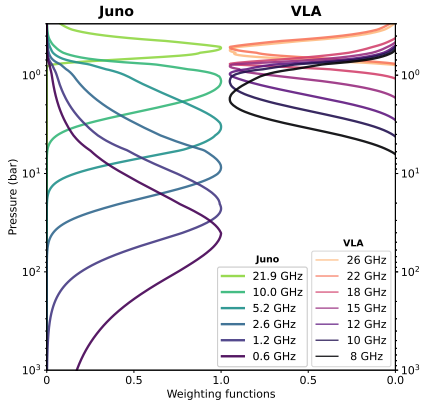2025-04-15 カリフォルニア大学バークレー校(UCB)
<関連資料>
- https://news.berkeley.edu/2025/04/15/on-jupiter-its-mushballs-all-the-way-down/
- https://arxiv.org/abs/2504.09943
- https://www.science.org/doi/10.1126/sciadv.ado9779
木星の熱帯大気-浅い天気、深い噴煙、そして渦 The Tropical Atmosphere of Jupiter – Shallow Weather, Deep Plumes, and Vortices
Chris Moeckel, Imke de Pater, Bob Sault, Bryan Butler
arXiv Submitted on 14 Apr 2025
DOI:https://doi.org/10.48550/arXiv.2504.09943

Abstract
Towering storms, swirling clouds, and vortices are the cloud tops manifestation of complex weather systems shaping the atmosphere of Jupiter. We use observations from Juno’s MicroWave Radiometer (MWR), the Very Large Array (VLA) and the Hubble Space Telescope (HST) to probe for the first time the depth and impact of weather on Jupiter. We use ammonia, the main source of opacity at radio wavelengths on Jupiter, as the tracer for the weather by fitting ammonia anomalies to the MWR brightness temperature variations. We show that the majority of the weather on Jupiter is confined to regions where the clouds are forming. Both the South Equatorial Belt and the Equatorial Zone have surprisingly shallow weather systems (P < 2 bar), and even in the North Equatorial Belt most of the ammonia variations is above the water condensation level (P ~ 6 bar). This confirms that the water condensation layer plays a crucial role in controlling the dynamics and the weather on Jupiter. However, the shallow nature of the weather cannot explain the deep-seated depletion down to 30 bar that the Juno mission has revealed. We do find three features, however, that extend below the water condensation layer: a vortex in the northern hemisphere reaching down to 30 bar, an ammonia plume down to 20-30 bars, and the signature of precipitation down to 20 bar. This work highlights the interplay of large-scale processes (vortices, plumes) and small-scale processes (storms) are responsible for shaping the atmospheric makeup of Jupiter.
対流圏の嵐: 木星大気深部における巨大嵐の影響のマッピング Tempests in the troposphere: Mapping the impact of giant storms on Jupiter’s deep atmosphere
Chris Moeckel, Huazhi Ge, and Imke de Pater
Science Advances Published:28 Mar 2025
DOI:https://doi.org/10.1126/sciadv.ado9779

Abstract
Storms are emerging as key drivers in shaping hydrogen-dominated atmospheres. Trace gas condensation can suppress convection and disrupt the distribution of energy and material in hydrogen atmospheres. On Jupiter, the presence of water has been invoked to control the occurrence of large-scale storms; however, the impact of storms on the ammonia and temperature distribution is unknown. We use Juno Microwave Radiometer observations of a large-scale storm in 2017 to study the aftermath of such a storm on the atmosphere. Anomalies in the retrieved ammonia abundance and atmospheric temperature show how storms deplete and heat the upper atmosphere while simultaneously depositing material well below the layers they were triggered at. These observations, aided by simulations, show that the water and ammonia cycles are coupled and that their combined effect plays a key role in explaining the depletion of ammonia in the tropospheres of Jupiter and Saturn.



